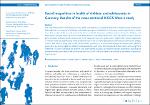Social inequalities in health of children and adolescents in Germany. Results of the cross-sectional KiGGS Wave 2 study
Kuntz, Benjamin
Rattay, Petra
Poethko-Müller, Christina
Thamm, Roma
Hölling, Heike
Lampert, Thomas
The close link between socioeconomic status (SES) and health can already be observed in childhood and adolescence.
Although the vast majority of children and adolescents grow up healthily in Germany, social inequalities in health
exist. The results of the second wave of the German Health Interview and Examination Survey for Children and
Adolescents (KiGGS Wave 2) demonstrate that children and adolescents with a low SES have a poorer level of
general health and face health constraints more frequently than their peers with a higher SES. Social inequalities
in mental health are significantly more profound than in the 12-month prevalence of bronchial asthma and allergic
rhinitis. The odds of being affected by mental health problems or attention-deficit/hyperactivity disorder (ADHD)
were 2.8 to 4.4 times higher for children and adolescents with a low SES compared to their peers with a high SES.
Therefore, in order to enable all children and adolescents to grow up healthily, health promotion and disease
prevention measures need to be put in place early in a child’s life and need to be tailored to the needs of particular
target groups.
Files in this item
Notes
Die deutsche Version des Artikels ist verfügbar unter: http://doi.org/10.17886/RKI-GBE-2018-076

